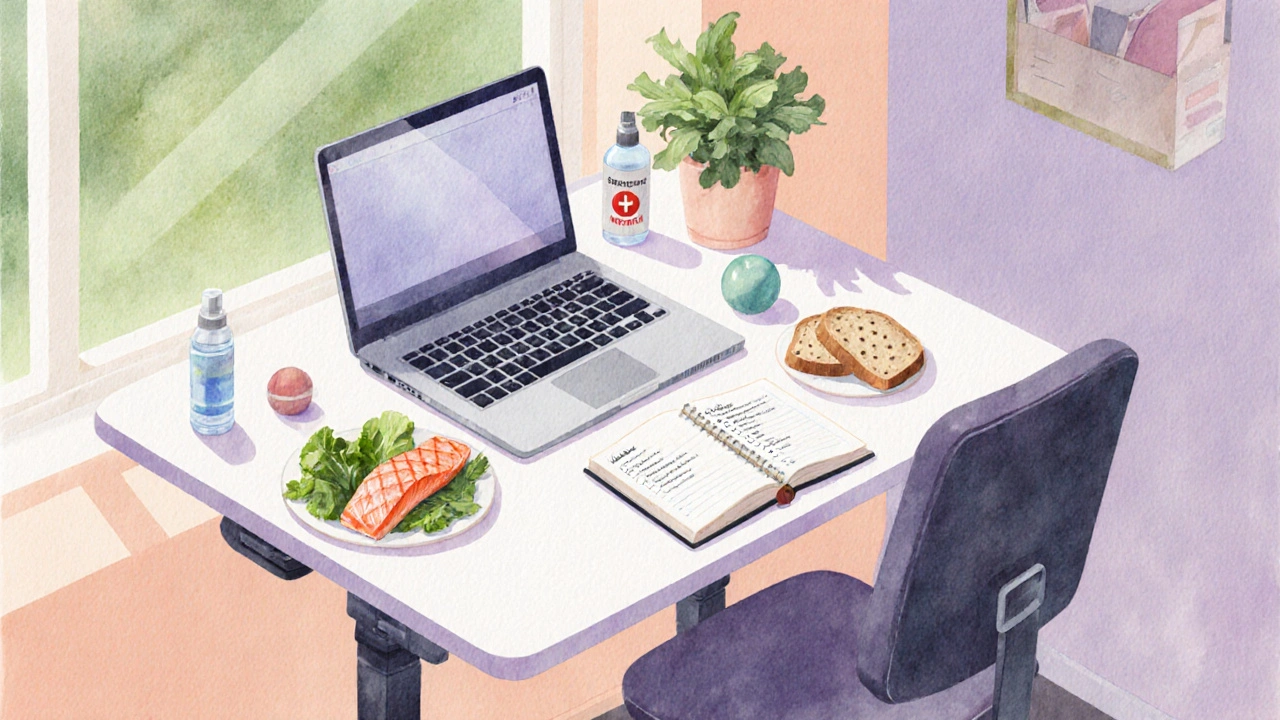Angina Trigger Assessment Tool
Identify Your Workplace Triggers
Select all factors that apply to your work environment
Living with Angina is a chest pain or discomfort caused by reduced blood flow to the heart can feel like walking a tightrope, especially when you spend eight or more hours a day at a desk. The good news? A handful of practical adjustments can keep the pain in check, lower the anxiety that builds around it, and still let you stay productive.
Quick Takeaways
- Know your personal warning signs and have a fast‑action plan ready.
- Adjust your workspace - lighting, temperature, and seating - to reduce cardiac strain.
- Use short, scheduled breaks for breathing or gentle movement; they cut stress hormones dramatically.
- Talk openly with your manager about reasonable accommodations before a crisis hits.
- Combine medication (like nitroglycerin) with lifestyle tweaks for the best long‑term control.
What Exactly Is Angina?
In plain terms, angina is a symptom of Coronary Artery Disease (the narrowing of heart arteries due to plaque buildup). When the heart muscle doesn’t get enough oxygen during activity or stress, you feel a squeezing, burning, or pressure sensation in the chest - often called Chest Pain. The discomfort can radiate to the jaw, arms, or back, and it might be accompanied by shortness of breath.
Why the Workplace Can Trigger Symptoms
Office life isn’t just about spreadsheets. Tight deadlines, noisy open‑plan areas, and even the posture you adopt while typing can raise heart rate and blood pressure. Research from the British Heart Foundation (2023) shows that workers who report high Stress have a 27% higher chance of experiencing angina episodes compared with calmer colleagues.
Common workplace triggers include:
- Prolonged sitting that reduces circulation.
- Caffeine‑heavy coffee breaks that spike adrenaline.
- Emotional pressure from tight deadlines.
- Poor air quality or temperature extremes in the office.

Practical Symptom Management at Work
When you feel the first twinge of pain, act fast. Here’s a step‑by‑step routine you can follow without drawing attention:
- Stop what you’re doing and sit or lean against a stable surface.
- Take a deep, controlled breath - inhale for four seconds, hold for two, exhale for six.If prescribed, place your Nitroglycerin tablet or spray under your tongue. The medication works within 1-3 minutes to widen blood vessels.
- Loosen any tight clothing, especially around the neck or waist.
- Notify a trusted coworker or supervisor that you need a few minutes to recover.
Having a small, discreet kit (nitroglycerin, a water bottle, and a quick‑release stress ball) in your bag minimizes disruption.
Stress‑Reduction Techniques That Fit a 9‑to‑5 Routine
Long‑term stress control beats occasional medication spikes. Try these low‑effort habits:
- Micro‑breaks: Every hour, stand up, stretch arms overhead, and roll shoulders for 30 seconds. Even brief movement improves coronary blood flow.
- Box breathing: Inhale 4s, hold 4s, exhale 4s, hold 4s - repeat four cycles. This lowers cortisol by up to 15% after a single session.
- Desk‑friendly meditation apps that guide a 5‑minute body scan, ideal for a lunch‑hour reset.
- Limit caffeine after 2p.m. Switch to green tea, which contains L‑theanine - a natural anxiety reducer.
Talking to Your Employer: The Right Way to Ask for Accommodations
Most UK employers are obligated under the Equality Act 2010 to make reasonable adjustments for heart conditions. Here’s a simple script you can adapt:
"I have a diagnosed heart condition that sometimes causes chest discomfort. To stay safe and productive, I’d like to discuss a few workplace adjustments, such as a flexible break schedule and a quieter workspace."
Follow these steps:
- Gather a brief doctor’s note outlining your condition and suggested accommodations.
- Request a private meeting with HR or your line manager.
- Present clear, feasible adjustments: extra short breaks, permission to keep medication on hand, and optional temperature control.
- Document the agreement in writing for future reference.
When the conversation stays factual and solution‑focused, most managers respond positively.

Medication & Lifestyle Planning - A Side‑by‑Side View
While medication controls immediate episodes, lifestyle changes lower the underlying risk. Below is a quick comparison to help you balance short‑term relief with long‑term health.
| Aspect | Short‑Term (Medication‑Focused) | Long‑Term (Lifestyle‑Focused) |
|---|---|---|
| Primary Goal | Immediate pain relief | Reduce plaque buildup |
| Typical Tools | Nitroglycerin, Beta Blockers | Heart‑healthy diet, regular aerobic activity, stress‑management techniques |
| Frequency of Use | As‑needed, often during flare‑ups | Daily habits, weekly exercise plans |
| Side Effects | Dizziness, low blood pressure | Initial fatigue (as fitness improves), possible dietary cravings |
| Long‑Term Impact | Controls symptoms but doesn’t halt disease progression | Can lower event risk by 30% over 5years (according to ESC 2022) |
When to Call a Doctor or Head to the Emergency Room
Know the red‑flag signals that demand professional help right away:
- Chest pain lasting longer than 5minutes despite medication.
- Sudden shortness of breath, nausea, or fainting.
- Pain that radiates to the left arm, jaw, or back and feels crushing.
- Any new symptom pattern that differs from your usual angina.
When in doubt, err on the side of safety - it’s better to have a quick check‑up than risk a heart attack.
Putting It All Together: A Daily Checklist for the Office
- Morning: Review medication schedule and pack emergency kit.
- Before sitting: Adjust chair height, place feet flat, keep screen at eye level.
- Every hour: Perform a 30‑second micro‑stretch and practice box breathing.
- Lunch: Choose a heart‑healthy meal (e.g., grilled salmon, mixed greens, whole‑grain bread).
- Afternoon: Limit caffeine, stay hydrated, and reassess any stress spikes.
- End of day: Log any symptoms in a notebook to discuss with your doctor.
Following a simple routine keeps you in control and shows your employer that you’re proactive about health.
Frequently Asked Questions
Can I keep my nitroglycerin tablet at my desk?
Yes. Under UK law, you may store prescribed medication at your workstation as long as it’s kept safely and you inform your employer if they ask for a health‑related risk assessment.
What type of exercise is safe during work hours?
Low‑impact activities like brisk walking, stationary cycling, or short stair climbs are ideal. Aim for 10‑minute bouts two to three times a day, keeping heart rate in a moderate zone (50‑70% of max).
Is it okay to ask for a quieter office space?
Absolutely. A quieter environment reduces sympathetic nervous system activation, which can lower blood pressure and heart rate. Request a corner desk, a private office, or noise‑cancelling headphones as a reasonable adjustment.
How often should I see my cardiologist if I work full‑time?
Typically every six months, or sooner if you notice a change in symptom frequency or intensity. Your doctor can fine‑tune medication dosages and suggest new lifestyle tweaks based on your work schedule.
Can stress‑relief apps be used at work without breaching company policy?
Most companies allow short wellness breaks as long as productivity isn’t affected. Choose discreet apps that run in the background or use your phone’s native timer to keep it professional.


Comments (13)
Thanks for the practical tips-I'll start adding short breathing breaks each hour.
Oh great, another list of 'simple' fixes-because corporate life is just a playground for heart health, right?
Man, dealing with angina at a desk feels like trying to juggle flaming swords while the boss watches. First off, know your personal warning signs like the back of your hand; the chest twinge is the alarm you can’t ignore. Second, the office chair isn’t a throne, so adjust it so your knees are at a right angle and your feet stay flat. Third, keep that caffeine intake in check-two cups of coffee is fine but the third is a ticket to a racing heart. Fourth, schedule micro‑breaks every 45 minutes; even a two‑minute breath‑in‑breath‑out routine calms the nervous system. Fifth, ask your manager for a flexible schedule if deadlines are crushing you; reasonable accommodations are a legal right. Sixth, keep nitroglycerin handy and know exactly where you left it; you don’t want to search the whole office during an episode. Seventh, stay hydrated; water improves circulation and eases the workload on your heart. Eighth, consider a standing desk or a sit‑stand converter; alternating posture keeps blood flowing. Ninth, use a simple mindfulness app on your phone to guide a quick body scan when stress spikes. Tenth, don’t forget to move during lunch-walk the hallway, stretch, or do a few light calisthenics. Eleventh, keep a log of when symptoms occur; patterns will reveal hidden triggers you hadn’t noticed. Twelfth, communicate openly with coworkers about your condition; they’ll often offer help you didn’t expect. Thirteenth, integrate regular cardio outside work, like brisk walking or cycling, to strengthen your heart over time. Fourteenth, talk to your cardiologist about any medication adjustments if your work stress changes. Finally, remember that taking care of yourself isn’t selfish; a healthier you means you can contribute more effectively at work.
If you think sitting is harmless stop it now.
The article correctly emphasizes the importance of posture and scheduled movement; maintaining these habits can significantly reduce cardiac strain.
Hey folks grab a cup of herbal tea and remember to stand up every hour you’ll feel better
Wow, just wow, another boring corporate wellness memo that pretends to care while you stare at a screen.
I get the frustration 😤 the advice actually helps if you stick to it.
Nice one! Adding a quick stretch will boost circulation 😊
One must appreciate the nuanced interplay between occupational ergonomics and myocardial oxygen demand, a symbiotic relationship often obfuscated by perfunctory corporate health directives.
Your summary aligns well with current cardiology guidelines; integrating brief mobility exercises and stress‑reduction techniques constitutes an evidence‑based approach.
I think we can all agree that small changes at the desk make a big difference for heart health.
I hear you loud and clear when you describe the relentless pressure that builds up in a bustling office environment. The way deadlines can feel like a ticking bomb in your chest is something many of us have lived through. When the air feels stale and the temperature swings from too cold to too hot, your cardiovascular system takes an unwelcome hit. Prolonged sitting is not just a comfort issue; it literally reduces venous return and can provoke angina symptoms. Switching to a standing position or taking a brief walk resets circulation and signals the body to relax. Caffeine, while a beloved office staple, spikes adrenaline and can precipitate that dreaded chest tightness. Replacing one cup with herbal tea not only cuts the caffeine surge but also introduces calming antioxidants. Stress‑reduction techniques, such as controlled breathing, have been shown to lower heart rate variability. Implementing a structured break schedule demonstrates to your employer that you are proactive about health. Open communication with your manager can lead to accommodations like flexible deadlines or ergonomic adjustments. Remember that medication adherence remains paramount; always have your nitroglycerin within arm's reach. By weaving these strategies into your daily routine, you transform a hostile workday into a manageable, heart‑friendly environment.